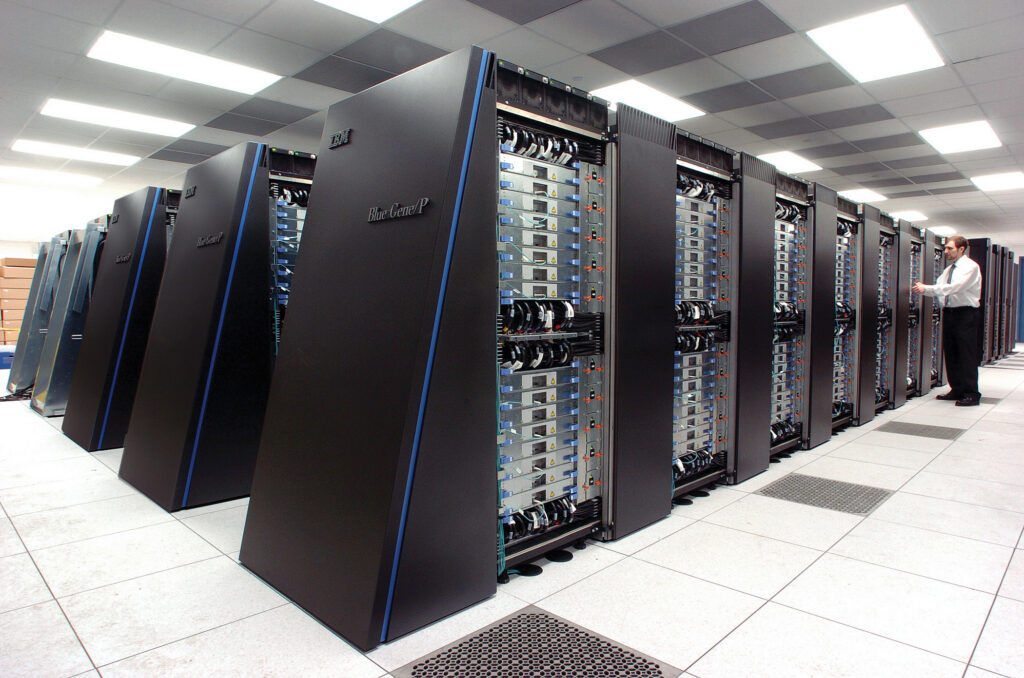Supercomputer, any of a class of extremely powerful computers. Supercomputing is a form of high-performance computing that determines or calculates using a powerful computer, a supercomputer, reducing overall time to solution. The term is commonly applied to the fastest high-performance systems available at any given time. Such computers have been used primarily for scientific and engineering work requiring exceedingly high-speed computations. Performance of a supercomputer is measured in floating-point operations per second (FLOPS) instead of million instructions per second (MIPS).

Definition of supercomputer:
A supercomputer is a computer with a higher level of performance than a general purpose computer. Supercomputer performance is measured in floating-point operations per second (FLOPS) rather than million instructions per second (MIPS). Supercomputers have thousands of processors and can perform billions and trillions of calculations per second. Some supercomputers can perform up to a hundred quadrillion FLOPS. Since information moves faster between processors in supercomputers (compared to distributed computing systems) they are ideal for real-time applications. Most supercomputers use a Linux-based operating system, with each manufacturer optimizing their own Linux derivative for peak hardware performance. In 2017, half of the world’s top 50 supercomputers used SUSE Enterprise Linux Server. The largest, most powerful supercomputers are actually multiple computers that perform parallel processing. SUSE Linux Enterprise High Performance Computing allows organizations to leverage their existing hardware for HPC computations and data-intensive operations.
Supercomputer size: In contrast, a supercomputer has a capacity of 200 to 300 gigabytes or more. Another useful comparison between supercomputers and personal computers is in the number of processors in each machine.
Examples where supercomputers are used:
Examples of special-purpose supercomputers include Belle, Deep Blue, and Hydra for playing chess, Gravity Pipe for astrophysics, MDGRAPE-3 for protein structure prediction and molecular dynamics, and Deep Crack for breaking the DES cipher. data-intensive and computation-heavy scientific and engineering purposes such as quantum mechanics, weather forecasting, oil and gas exploration, molecular modeling, physical simulation, aerodynamics, nuclear fusion research and cryptanalysis.
What is supercomputing used for?
Supercomputers is basically used by corporations and government organizations to simulate outcomes. These blazing fast computers can be used for everything from finding new oil repositories to developing new life-saving medicines. In fact, supercomputers all over the world are being used to assist in research and development.
Where are supercomputer used?
Traditional uses for supercomputers have been in oil and gas exploration, converting seismic data into maps that indicate where to drill oil and/or gas wells. They are employed in engineering simulations such as fluid dynamics calculations on automobiles that look at drag and aerodynamic efficiency.
History of supercomputer:
In 1960, UNIVAC created the Livermore Atomic Research Computer (LARC), which is today considered the first supercomputer for the US Navy Research and Development Center. It still uses high-speed drum memory instead of the newly emerging disc drive technology. In addition, the first supercomputers were the IBM 7030 Stretch. The IBM 7030 was built by IBM for the Los Alamos National Laboratory, which requested a computer 100 times faster than any existing computer in 1955. The IBM 7030 used transistors, magnetic core memory, pipelined instructions, data prefetched via memory controllers, and included the pioneering random access disk drive. The IBM 7950 became the basis for the Harvest, a supercomputer designed for cryptanalysis.
The CDC 6600, designed by Seymour Cray, was finished in 1964 and marked the transition from germanium to silicon transistors. Silicon transistors could run more quickly and the overheating problem was solved by introducing refrigeration to the supercomputer design.
Who invented supercomputer?
Seymour Cray or Boris Babayan are invented supercomputer.
Seymour Cray:

Seymour Roger Cray (September 28, 1925 – October 5, 1996) was an American electrical engineer and supercomputer architect who designed a series of computers that were the fastest in the world for decades, and founded Cray Research which built many of these machines. Called “the father of supercomputing”, Cray has been credited with creating the supercomputer industry. Joel S. Birnbaum, then chief technology officer of Hewlett-Packard, said of him: “It seems impossible to exaggerate the effect he had on the industry; many of the things that high performance computers now do routinely were at the farthest edge of credibility when Seymour envisioned them.
Boris Babayan:
Babayan and his team built their first computer during the 1950s. In the 1970s, chief architect V.S. Being one of Burtsev’s 15 deputies, he worked on the first superscalar computer, Elbrus-1, and the programming language ль-76. Using these computers in 1978, ten years before commercial applications appeared in the West, the Soviet Union developed its missile systems and its nuclear and space programs.
A team led by Babayan designed the Elbrus-3 computer using an architecture called explicitly parallel instruction computing (EPIC).

Supercomputer distinguishing features:

Supercomputers have some unique characteristics. Here we will tell you about those features:
- Unlike normal computers, they usually have more than one CPU (central processing unit), with circuits to interpret program instructions and execute arithmetic and logic operations in the proper order.
- In various supercomputer systems, the processor and memory circuits are immersed in cryogenic fluid to achieve the lowest temperature at which they operate most rapidly.
- Supporting the CPU’s extremely high computational speed requires rapid retrieval of stored data and instructions. Therefore, most supercomputers have very large storage capacities, as well as very fast input/output capabilities.
- Supercomputers were originally used in applications related to national security, including nuclear weapon design and cryptography.
- Today they are regularly employed by the aerospace, petroleum and automotive industries. In addition, supercomputers have found wide application in fields related to engineering or scientific research, for example, in the study of the structure of subatomic particles and the origin and nature of the universe.
- Supercomputers have become an indispensable tool in weather forecasting: predictions are now based on numerical models. As the cost of supercomputers went down, their use spread to the world of online gaming. Notably, in 2007 the 5th to 10th fastest Chinese supercomputers were owned by a company in China with the online rights to the electronic game World of Warcraft, which sometimes has more than a million people playing simultaneously in the same gaming world. were.
Supercomputer names:
Supercomputer names:
CDC 6600: In the beginning, 1964, there was the Control Data Corporation 6600, the first supercomputer.
Here’s the 10 fastest supercomputers in the world:
TOP 10 FASTEST SUPERCOMPUTERS IN THE WORLD:
- Summit | U.S.
- Sierra | U.S.
- Sunway TaihuLight | China
- Tianhe-2A | China
- Piz Daint | Switzerland
- Trinity | U.S.
- ABCI | Japan
- SuperMUC-NG | Germany
- Titan | U.S.
- Sequoia | U.S.
In this article we have try to define “what is supercomputer?”. Hope you are like it! Thanks for reading this article.
